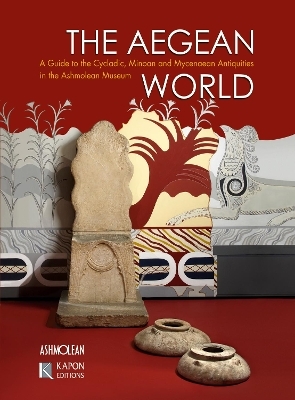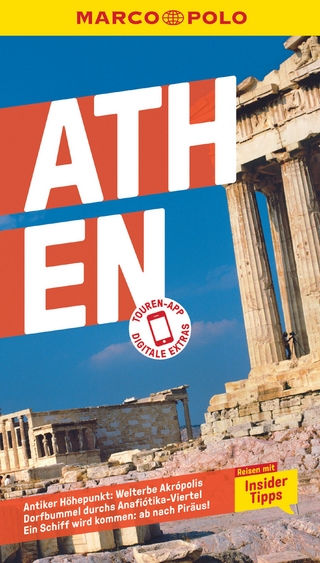
The Aegean World
A Guide to the Cycladic, Minoan and Mycenaean Antiquities in the Ashmolean Museum
Seiten
2013
Kapon Editions (Verlag)
978-960-6878-59-6 (ISBN)
Kapon Editions (Verlag)
978-960-6878-59-6 (ISBN)
- Titel nicht im Sortiment
- Artikel merken
This is the first companion guide on the Ashmolean's outstanding 12,000 object Aegean collection, the best and most comprehensive outside Greece including Neolithic and Cycladic antiquities, the best Minoan collection outside Crete. 362 col illus. published in collaboration with the Ashmolean Museum, University of Oxford.
This is the first companion guide ever to be written on the Ashmolean's outstanding Aegean collections, the best and most comprehensive outside Greece. Comprising 12,000 objects, the Ashmolean holds a remarkable collection of Neolithic and Cycladic antiquities, the best Minoan collection outside Crete, and a comprehensive corpus of Mycenaean antiquities. It is thanks to the indefatigable work of Sir Arthur Evans, and other great Aegean pioneers, such as Sir John Linton Myres and David Hogarth, that the Ashmolean, with its rich archival resources, stands out today as one of the most important museums for the study of Aegean archaeology.
The companion guide, written by top scholars in the field, takes a chronological as well as thematic approach to the study of the Aegean collections. The texts, written with the wider audience in mind, introduce readers to the history of the collection and its current display strategy, Sir Arthur Evans and his work in Crete, the world of the early Cyclades, Knossos and Minoan Crete, Mycenaean Greece, and the Aegean seals and scripts that were central in Evans's archaeological research on the island.
The companion guide is beautifully designed and richly illustrated throughout. Images of the gallery, of individual objects and group shots, maps, plans, and timelines, provide the reader with the feel of the Aegean World gallery, which since its opening in 2009 has been enthusiastically received. The book follows the strategy developed specifically for the Aegean World gallery at the Ashmolean Museum: 'how we know what we know?' about Aegean prehistory, and the role of archaeologists as filters through whom our knowledge of the past is diluted and shaped. The guide also includes about 80 highlighted objects, which are accompanied with new photographs - specifically taken for this publication, a brief description and bibliography.
The companion guide is published in collaboration with the Ashmolean Museum, University of Oxford.
This is the first companion guide ever to be written on the Ashmolean's outstanding Aegean collections, the best and most comprehensive outside Greece. Comprising 12,000 objects, the Ashmolean holds a remarkable collection of Neolithic and Cycladic antiquities, the best Minoan collection outside Crete, and a comprehensive corpus of Mycenaean antiquities. It is thanks to the indefatigable work of Sir Arthur Evans, and other great Aegean pioneers, such as Sir John Linton Myres and David Hogarth, that the Ashmolean, with its rich archival resources, stands out today as one of the most important museums for the study of Aegean archaeology.
The companion guide, written by top scholars in the field, takes a chronological as well as thematic approach to the study of the Aegean collections. The texts, written with the wider audience in mind, introduce readers to the history of the collection and its current display strategy, Sir Arthur Evans and his work in Crete, the world of the early Cyclades, Knossos and Minoan Crete, Mycenaean Greece, and the Aegean seals and scripts that were central in Evans's archaeological research on the island.
The companion guide is beautifully designed and richly illustrated throughout. Images of the gallery, of individual objects and group shots, maps, plans, and timelines, provide the reader with the feel of the Aegean World gallery, which since its opening in 2009 has been enthusiastically received. The book follows the strategy developed specifically for the Aegean World gallery at the Ashmolean Museum: 'how we know what we know?' about Aegean prehistory, and the role of archaeologists as filters through whom our knowledge of the past is diluted and shaped. The guide also includes about 80 highlighted objects, which are accompanied with new photographs - specifically taken for this publication, a brief description and bibliography.
The companion guide is published in collaboration with the Ashmolean Museum, University of Oxford.
Editor’s Acknowledgements
Preface
The Redeveloped Ashmolean Museum - Susan Walker
The ‘Aegean World’ at the Ashmolean - Yannis Galanakis
Arthur Evans and Minoan Crete - Lesley Fitton
The Cyclades in the Early Bronze Age - SuSan Sherratt
Minoan Crete: People in a World of Objects and Places - John Bennet
Mycenaean Greece: from Crete to the Mainland of Europe and Back - Jack Davis
The Aegean Bronze Age Scripts - Lisa Bendall
Seals of Bronze Age Greece - Helen Hughes-Brock
Endnotes
Reading List
The Chronology of Bronze Age Aegean
Index
| Erscheint lt. Verlag | 24.7.2013 |
|---|---|
| Zusatzinfo | 362 col illus. |
| Verlagsort | Athens |
| Sprache | englisch |
| Maße | 196 x 267 mm |
| Gewicht | 749 g |
| Themenwelt | Kunst / Musik / Theater ► Kunstgeschichte / Kunststile |
| Reiseführer ► Europa ► Griechenland | |
| Geisteswissenschaften ► Archäologie | |
| Geschichte ► Allgemeine Geschichte ► Altertum / Antike | |
| ISBN-10 | 960-6878-59-7 / 9606878597 |
| ISBN-13 | 978-960-6878-59-6 / 9789606878596 |
| Zustand | Neuware |
| Haben Sie eine Frage zum Produkt? |
Mehr entdecken
aus dem Bereich
aus dem Bereich


